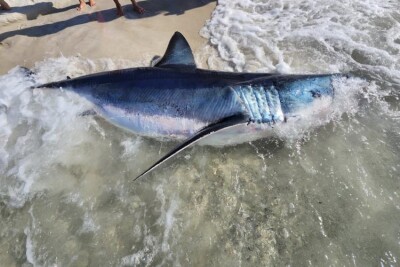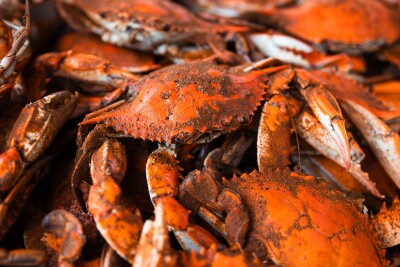Northeast
Yard builds its first 47-footer; steel dragger ends a dry spell
H&H Marine in Steuben, Maine, launched the Brahma Bull, one of their wide 42s, on Nov. 8, and the boatyard's first 47-footer was scheduled to go into the water in late December in nearby Milbridge.
The 42-footer is for Cutler, Maine's Wendell Davis who will use it for lobstering in the spring and fall, and scalloping in the winter. The Osmond Beal design has a maximum beam of 17' 6" and measures 16' 8" across the transom.
With those two fisheries in mind, Davis had H&H Marine build the wheelhouse with a winter back and a side panel that slides in on a track along the starboard side. When lobstering, the panel will be removed, but in the winter, the panel will slide in place to close up the wheelhouse to the weather. The winter back has a sliding door that opens onto the working deck.
The working platform is fiberglassed plywood over pressure-treated beams. The deck was given a coating of Philly Clad, a "durable non-skid urethane covering that's a whole lot lighter than deck tiles, and lasts forever," says H&H Marine's Bruce Grindal. However, Grindal isn't sure Philly Clad is still being made, as his distributor says he has only a small amount left.
Down in the Brahma Bull's engine compartment is a 650-hp Scania diesel for power. It's hooked up to a ZF 325-1A marine gear with a 2.4:1 reduction that turns a 34" x 36" four-bladed prop fast enough to push the 42-footer to 23.8 knots.
Davis runs his hydraulics off the transmission. "He can run a 50-gallon-per-minute gear pump off the transmission, with a selector valve to engage and disengage the transmission. Nowadays, the 500- to 600-horsepower engines with bigger offset gears, most everyone goes with that option instead of a drive line off the front. It's a lot cleaner and safer," says Tim Toppin of Toppin's Diesel in Columbia Falls, Maine, who installed Davis' engine and gear.
H&H Marine's first 47-footer was built for Derek Feeney of Cutler. The 47' x 19' 2" (18' 6" across the open transom) lobster boat has a split wheelhouse and a fish hold. For power there is an 800-hp Scania diesel in front of a ZF 360-A marine gear with a 2.47:1 reduction. The four-blade prop measures 38" x 36".
Feeney's boat also uses Philly Clad over a fiberglass and plywood working platform with Freeman aluminum deck hatches.
After Feeney's boat left H&H Marine, two more 47-foot hulls had to be built. These are going out as kit boats. One to a fisherman in Massachusetts who will use it for lobstering and dragging and the other hull to a Mount Desert Island fisherman who will finish it off as a dragger.
Besides those two boats, a wide 42 is going to Monhegan for lobstering, gillnetting and duty as a pilot boat.
In mid-December, there was an uncommon object tied off to the docks at Fairhaven Shipyard in Fairhaven, Mass. It was a newly built steel dragger. How uncommon is that? Well, it's been more than 60 years since Fairhaven Shipyard built its last dragger and many years since a steel dragger was built in New England.
The 83' x 24' x 13' Elizabeth was designed by Farrell and Norton Naval Architects of Fairhaven, Mass., and Newcastle, Maine, for an owner who wishes to remain anonymous.
The Elizabeth was built to ABS standards with a single-chine hull that is longitudinally framed fore-and-aft of the fish hold. Whereas there is transverse framing for the 4,100-cubic-foot fish hold.
In the engine room is a single 540-hp Caterpillar 3412C diesel bolted to a Reintjes WAF 364 marine gear with a 6:1 ratio that spins the prop inside a 72-inch Rice nozzle. Up in the forward part of the boat is an 18-inch Keypower Equipment bow thruster for maneuvering around the docks.
Caterpillar engines are also used for the trawl winches and genset: a 405-hp C12 powers the winches' hydraulic motors and a C4.4 puts out 44 kW.
Outside the hull, the bilge keels are double plated for additional strength when the boat is hauled.
After completing its outfitting, the Elizabeth was scheduled to leave Fairhaven around the end of January. That's just about a year after the keel was laid. — Michael Crowley
West
Flood of gillnetters to be built; 58-footer proves to be popular
In May 2007, Freddy's Marine in Homer, Alaska, launched a pair of 30-foot fiberglass bowpickers for the Copper River salmon fishery. By this spring, Freddy's Marine will have built 13 more bowpickers from the same mold for Copper River gillnetters.
Two of the boats will be finished off by the boatyard. The remaining 11 will go out of the boatshop as bare hulls to be finished off by the fishermen.
Three of the boats will be 30-footers and 10 — by extending the molds — will be stretched to 32 feet. This will be the first time Freddy's Marine has extended a 30-footer. One benefit of the extra 2 feet, says Fred Martushev, the boatyard's owner, is to improve the fuel economy and put less stress on the engine.
"Now the 30-footer is cruising at 29 knots at 3,500 rpm. That's a little heavy for the engine. But you extend it 2 feet and do only 3,300 at 29 knots. That will be easier for the engine to handle," Martushev says. He adds, "at full bore all are 37 knots, give or take."
In mid-December, all the boats but one were scheduled to have twin 370-hp Chevy gasoline engines hooked up to Hamilton 213 water jets. The lone exception is a pair of 410-hp 8.1-liter Kodiak Marine gasoline engines, which are also hooked up to Hamilton 213s.
There always seems to be a number of Alaska gillnetters that pick the power of a gasoline engine over a diesel engine because a gasoline engine costs less, but mostly because the boat is quicker out of the hole. "If you have gas and punch it, you pick up fast and strong. You will just pop out of the water. The diesel doesn't have the torque," Martushev says.
The hulls are designed as planing hulls with a reverse chine or gull wing. The reverse chine starts out as 6 inches at the transom, carries that width to about amidships and then starts tapering down to nothing at the stem. The bow has a radius-V shape that is carried back to about amidships and then transitions to straight-line-V sections.
In Reedsport, Ore., at Fred Wahl Marine Construction, the 58' x 26' Alaskan Dream pulled away from the boatyard's docks the week of Thanksgiving and headed for Alaska, where she will be longlining and crabbing.
This is the second 58-footer built to this Fred Wahl Marine Construction design. The first boat was the Arctic Fox. Shortly after the Alaskan Dream headed into the Pacific, the yard laid a steel keel for a third 58-footer. Also in the works is a 61- or 62-foot in-house design for a squid boat going to California, says the boatyard's Mike Lee. There have been a lot of inquiries about the 58-foot design, so Lee foresees building a number of boats like the Alaskan Dream and Arctic Fox.
Besides launching new boats, the crew at the boatyard has been working to finish off a number of repair jobs. One of those is the 100-foot Marcy J out of Kodiak. This is a dragger that was built at Bender Shipbuilding & Repair in Mobile, Ala., and was later sponsoned at Nichols Brothers Boat Builders, in Freeland, Wash.
At Fred Wahl Marine Construction, the Marcy J was getting a new main engine. A 725-hp Caterpillar 3408 was hauled out and replaced with a 1,300-hp Caterpillar 3512B. With an engine delivering nearly double the previous engine's horsepower, a larger cooling system and exhaust had to be installed, along with a new reduction gear, shaft and rudder.
The Marcy J was due to head back to Kodiak around the first of the year.
Another trawler in for a repowering that was expected to leave in early January is the 59-foot Kruzof. In this case, a 500-hp Lugger was replaced with a 600-hp Volvo Penta.
In March or April, the 150-foot Ocean Prowler, a heading, gutting and freezing boat is due in to have her bow replaced. This is an old Navy boat that doesn't
have much freeboard in the bow area, thus takes a lot of water over the bow.
"We'll cut off the old bow and build a new bow section to raise the bow up. It will have a bulb," Lee says. — Michael Crowley
South
Scalloper joins company of 22; Model A motor still pulls boats
John W. Gilbert Associates of Hingham, Mass., and Duckworth Steel Boats in Tarpon Springs, Fla., teamed up to design and build three scallopers for Eastern Fisheries of New Bedford, Mass.
The first boat, the Polaris, which measures 93' x 28' x 14' 6", was delivered recently to Eastern Fisheries. The Polaris is a sister ship to the Neskone, another Eastern Fisheries scalloper, built in 2006 at Eastern Shipbuilding in Panama City, Fla.
The Polaris is powered by a Caterpillar 3508 engine rated at 900 hp at 1,600 rpm and is coupled to a Reintjes WAF 561 marine gear. The 93-footer doesn't have freezing capacity but was built so freezers could be added. The Polaris carries a seven-man crew but is designed for 11 in case regulations ever allow that large a crew.
The other two scallopers being built at Duckworth Steel Boats are the Wisdom and the Horizon. Both boats are identical to the Polaris.
The Wisdom was due to be launched in December and delivery is scheduled for late January. The Horizon should hit the water by late summer. Peter Anthony, manager of dockside repairs at Eastern Fisheries, says the New Bedford fishing company is the largest scallop business in the world with 22 boats working in the Atlantic scallop fishery.
"We have focused on the fishery and made every effort to work it right," he says. "We are real happy with Duckworth's work. We have used other yards and been happy with them, too, but when we started looking around for a builder, Duckworth could deliver in the time period we needed and his [bid] came in very sharp, too. We had known about Duckworth for a long time and seen his work. We knew they do quality work," Anthony says.
Down in Virginia, Winegar's Marine Railway in White Stone, which specializes in repairing and maintaining wooden commercial fishing boats, has the Bay Princess on one of its marine railways. Once it leaves the boatyard, the boat will be gillnetting in the Atlantic.
Terry Guthrie of Harkers Island, N.C., built the 40' x 14' Bay Princess in 1988 with strip-planked sides and a lot of flare in the bow. The boat is having work done to the exhaust system, including a new exhaust elbow for a Caterpillar 3406 engine. The Bay Princess has been on the railway for several weeks waiting for parts.
Cathy Winegar Davenport, who owns and operates the railway, is one of the few women running a marine railway on Chesapeake Bay. (She and her husband, Ray, own the Bay Princess.) Davenport's grandfather started the boatyard in 1911, and her father ran the yard when her grandfather died. In 1982, she took control when her father died.
At least one piece of the boatyard's equipment goes back to the time of Davenport's grandfather. That's the 1929 Model A Ford engine that her grandfather bought to provide the power to haul boats out of the water and up the railway. When Davenport is asked why the 78-year-old engine hasn't been replaced, she says, "It worked for my father and grandfather, and it works for me."
The longtime builder of wooden boats Edward Diggs of Redart, Va., is rebuilding the bottom of a Chesapeake Bay crab skiff. The wooden skiff is used in the bay and rivers to harvest hard- and soft-shell crabs and for gillnetting.
Diggs has retired from building large boats for Chesapeake Bay. From the 1950s to the 1990s, he built 42-foot to 50-foot wooden deadrise workboats for Chesapeake Bay commercial fishermen.
Diggs got started in boatbuilding as a boy, "blowing sawdust off my father's saw mark," he remembers. Diggs and his father, Edgar, and uncle Ned Hudgins built boats in Peary, Va., until 1953
That year, boatbuilder Alton Smith got an order to build a 65-foot Chesapeake Bay buy boat and hired the father-and-son boatbuilding team to help him with the project. When Smith retired in the early 1970s, Diggs took over the business and built numerous deadrise boats at Horn Harbor Marina in Port Haywood, Va.
Diggs has a reputation of being one of the finest deadrise builders on the bay and still gets calls for boats. Each year, he builds one or two new flat-bottom or deadrise skiffs ranging from 15 to 22 feet in the combination garage and boat shed beside his home. — Larry Chowning






